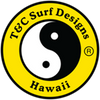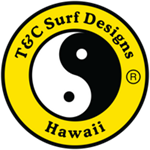The Spouting Waters of O’ahu
The south shore of Oahu has seen many changes throughout the centuries. Paradise lost; kings, queens, and conquerors; globalization and high-rise hotels. Le’ahi has seen them all. She has also seen incredible beauty. Paradise found; Duke Kahanamoku’s legendary ride; Rabbit Kekai’s first nose-ride; a child named Carissa Moore’s first wave.

Throughout the changes on land, the surf in Waikiki has remained a constant. It is what has gathered people together from far and wide and has played a key role in preserving the beauty of the place. With over 30 named spots from Diamond Head to Point Panic, the reefs and beaches of Waikiki have become some of the island’s most cherished and valuable resources, attracting a steady inflow of vacationers year-round, generating approximately 42% of the state's visitor industry revenue and is responsible for 8% ($5 billion) of the Gross State Product. For the most part, you can thank surfing for that.
Waikiki translates to “spouting water’’ in English. It was mostly marshland and a popular gathering place for the Oʻahu royal family since the 15th century. It was much larger then, including the Mānoa and Palolo Valleys. In 1794, a famous battle took place in Waikiki when Kamehameha I arrived from Hawaiʻi Island with a fleet of canoes. They stormed the beach in pursuit of Oʻahu Chief Kalanikupule and his warriors, which Kamehameha subsequently overthrew. In the following years, King Kamehameha I moved his royal court to Waikiki to be closer to the expanding city due to the rise in trade. It was in Waikiki during this time that Hawaiian royalty was frequently seen surfing, by many, for the first time ever. The next century would see major change in the area, including the first roads, the first hotels, an influx of foreign interest, and eventually military bases established by the United States at Pearl Harbor and central Oʻahu. By the end of the century, in 1898, Hawaiʻi was annexed by the USA.

In the early 1900’s the Moana Surfrider and Royal Hawaiian Hotels were constructed. Tales of an island paradise would woo many intrepid visitors to the islands by steamship and inevitably to Waikiki. Authors including Mark Twain, Robert Louis Stevenson, May Sarton, and James Jones would yarn about the tropical landscape and popularize the faraway land. Twain wrote about trying surfing and apparently failing terribly at it. One famous writer in particular that was awestruck by the act of surfing and wrote about his encounter with the “sport of kings” as he called it, was American explorer and novelist, Jack London, author of The Call of the Wild, and White Fang. He would recount his trials and tribulations with surfing in his 1907 essay “Learning Hawaiian Surfing.” The surf-stoked young writer penned in great detail, the amusing account of his first two days of surfing. Despite the somewhat outdated vernacular of London’s writing, you can almost smell the salt air of Waikiki and hear the waves rolling in this familiar tale of one man's encounter with the sea, feeling his smallness amongst it, encompassed in the beauty of it, and inspired to be apart of it. As he sat there safely on the shore, he saw a Hawaiian man riding a wave. London writes, “he is flying through the air, flying forward, flying fast as the surge, on which he stands. He is a Mercury—a brown Mercury. His heels are winged, and in them is the swiftness of the sea.”
As Jack London attempts to surf in what seems to be the shore break on what is described to be a small wooden bodyboard, he fails miserably until he gets a bit of help from a friend named Alexander Hume Ford. “Hume,” as he was called by the Hawaiians, was a magazine editor, playwright, photographer, promoter, and founder of Hawai’i’s Outrigger Canoe Club. He helped promote Duke Kahanamoku and George Freeth to an American and Australian audience and may have been the first surf photographer. On this particular day, Hume lent London his board and helped him survive his first day of surfing. Hume told him, "Tomorrow, I am going to take you out into the blue water." The next day the two set out past the shore break and met with George Freeth. Freeth was a Hawaiian-Irish surfer and lifeguard from O’ahu who was instrumental, along with Duke Kahanamoku, in bringing surfing to California and beyond. London writes of Freeth, “I saw him tearing in on the back of it, standing upright on his board, carelessly poised, a young god bronzed with sunburn.” The three would surf four hours that day. London would scribe the account from his bed, regrettably too sunburned for a third day in a row, but the story ends with the surf-bitten author vowing to return to the waves. The essay was much of the modern world's first glimpse at he’e nalu and was instrumental in the rise of surfing. In the years to come, Hume would continue promoting surfing through his own writing, photography, and surfing exhibitions featuring George Freeth and, later, Duke Kahanamoku.

Volumes have and could be written about Duke Kahanamoku’s life and legacy. His influence on surfing is unparalleled. As a lifeguard, he saved countless lives and pioneered using surfboards in ocean rescue. Duke Kahanamoku grew up in Waikiki, near where the Hilton Hawaiian Village sits today. Kahanamoku was also a world-class swimmer. On August 11, 1911, Kahanamoku was timed at 55.4 seconds in the 100 yards freestyle, beating the existing world record by 4.6 seconds. He also broke the record in the 200 meter and equaled it in the 50 yd. But the Amateur Athletic Union, in disbelief, would not recognize these feats until many years later. He braved many obstacles, including racism, and would go on to win three Olympic gold medals and two silver medals over three Olympics from 1912 to 1924. Kahanamoku’s Olympic achievements would garner global attention for himself and the sport of kings.
Of the many legends of surfing and legendary waves ridden in surfing’s history, none compare with Duke Kahanamoku’s nearly mile-and-a-half-long ride through Waikiki. It was May, 1917, a massive Tasman Sea swell was slamming into the south shores. Duke and a few friends grabbed their Olo boards and paddled far beyond the breakers until they reached past what is known today as Castles. Kahanamoku waited patiently for the set wave, and as the legend goes, Duke plummeted down the face of the massive wave, and as he began to ride, pointed his board towards the bay of Waikiki. The wave carried him along as he made the connection to the next break, known as Public’s, then connected it to the next break, now called Cunah’s, and onward through outside Queen’s. After riding more than a mile, he reached outside Canoe’s, and as a mass of whitewater exploded all around him, he emerged with his board pointed straight at the beach. He rode the wave another few hundred yards and stepped off onto the shore right in front of the Moana Surfrider. They say history repeats itself, but this is one historical ride that will likely never be duplicated. Many claim changes like the construction of the Ala Wai Canal have altered the natural environment along with the surf.

Today much has changed on land and in the water, but much stays the same. With the ocean at your back, the Waikiki of today must look unrecognizable to visitors like Jack London or locals like George Freeth. But facing the horizon, Waikiki might look much like it did in those days, minus a few hundred people. Like Jack London, voyagers still flock to Waikiki, seeking adventure beyond the shore. And like Freeth, the Hawaiian waterman still slides upon the sea, as London described, “In truth, from out of the sea he has leaped upon the back of the sea, and he is riding the sea that roars and bellows and cannot shake him from its back.”

Yeah, Le’ahi has seen a lot of changes, yet some things have never changed; O’ahu is still the gathering place, Waikiki continues to be the epicenter of heʻe nalu, and surfing will always be the sport of kings.






Leave a comment